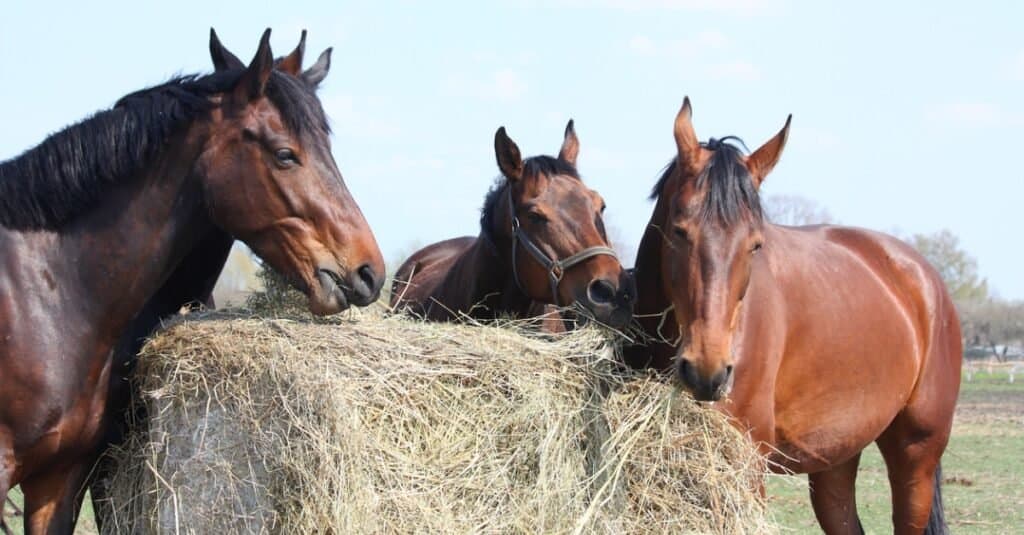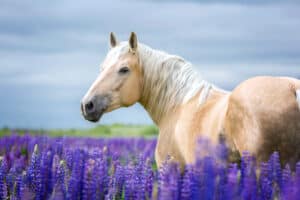
It’s impossible to imagine human civilization without the horse. Domesticated from wild horses about 6,000 years ago on the steppes around the Black and Caspian Seas, the horse has been used to fight wars, hunt other animals, carry burdens, pull carriages, and simply for the pleasure of riding them and keeping them as pets. In some places, it must be said, they’re also food for people. The horse is a rather strict herbivore, and we know things have gone really bad in the world of Macbeth when Ross confirms that the king’s horses have taken to eating each other. But what sort of “herbs” does the horse eat? Are they different for a horse that lives in the wild than for a horse that’s a pet? Read on to find out.
What Foods Do Horses Eat?

©iStock.com/virgonira
Horses eat grass, hay, and other types of forage. But before we investigate this, a word should be said about the horse’s digestive system, which can be surprisingly fragile. Everything that enters a horse’s GI tract must go one way, which is down, across, and eventually out. Because of the cardiac sphincter that shuts their esophagus and the angle at which the esophagus connects to their stomach, horses can’t vomit and are subject to a condition called choke. Choke isn’t like food going down the wrong pipe in humans, for the horse can still breathe, but its food is stuck in the esophagus. Since the horse can’t vomit it out, it’s not going anywhere. Choke is a medical emergency, one of a number that has to do with the horse’s digestive system.
Another thing to know is that the horse’s stomach is small for the size of the animal and empties when it’s about two-thirds full, even if the food isn’t completely digested. Because of this, it’s ideal for a horse to graze throughout the day as opposed to being fed one or two big meals. The horse also lacks a gall bladder, so its system secretes bile all the time.
A horse’s digestive system needs a way to break down the cellulose found in grass, but unlike a cow, it only has one stomach. The plant fiber that horses eat is broken down in their cecum as opposed to a multi-chambered stomach. The cecum is the first part of their large intestine. Also called the water gut, it uses microbes to break down plant fiber. Once broken down, the food can be passed on to the rest of the large intestine, but the horse is still not home free. The animal’s colon can be 25 feet long and has so many twists and turns that the horse is also subject to potentially fatal types of colic. This is why it’s so important for a horse owner to oversee the horse’s diet, and feed it the right foods the right way.
Forages that make up a horse’s diet include:
- Grasses such as bent grass, bluestem, brome, fescues and Kentucky bluegrass
- Green hay
- Clover
- Alfalafa
- Butterfly beans
- Vetches
- Yrefoil
- Oats
- Corn
- Barley
- Wheat
- Bran
- Linseed, which should be boiled before offering to the horse
- Fruits such as apples
- Root vegetables such as carrots and turnips
Horses also must have plenty of fresh, clean water and a salt lick.
What Do Horses Eat as Pets vs. in the Wild?
A well-cared-for pet horse can have a varied diet with oats, wheat, bran, and even molasses and cod liver oil though all it needs is some forage, especially hay, lots of water, and a salt lick. However, a horse that does a lot of work or a horse that’s growing, pregnant, or lactating might need supplemental vitamins and minerals. Some owners give the horse supplemental sugar beets, but they must be soaked for at least half a day before they’re fed to the horse, as dry sugar beets can swell up and cause another potentially fatal digestive problem. Some people feed their horse a commercial grain mix made up of oats, corn, barley, and other foods along with hay. The best hay is still green, dry but not too dry. It’s made of grasses and legumes and has stems, leaves, and seed heads that haven’t quite opened up.
Horses that live in the wild don’t eat hay, which has to be prepared by humans. A truly wild horse such as the endangered Przewalski’s wild horse is also a strict herbivore and spends much of its day foraging where it lives in Mongolia. Besides grass, it also eats beans, asters, trefoil, peas, vetches, and cat grass. During the colder months, it eats the bark, twigs, and fruit of trees and shrubs such as willows, apples, pears, pines, roses, and alders. If there’s snow on the ground, the horse will scrape it away to search for hidden grasses such as brome.
Feral horses such as the mustangs found in the western part of the United States also eat grasses such as Indian ricegrass, wheatgrass, and other perennial grasses. They also eat flowers such as sunflowers, coneflowers, and thistles as well as the branches of maples, willows, sage, and junipers. Some will even eat soil, probably for its minerals.
How Do Horses Hunt Prey?

©Callipso88/Shutterstock.com
As herbivores, horses don’t hunt prey, but as they munch grass they inevitably pick up insects and small arthropods such as spiders.
What Animals Eat Horses?
Even though they’re big animals — a Shire horse can stand 5.7 feet high at the shoulder and weigh close to 2,700 pounds — horses are prey animals. They descend from a creature that was no bigger than a small dog and weighed 12 pounds. Modern horses are still subject to predation by cougars, wolves, bears, and coyotes. Humans also hunt and eat horses or even raise them for their meat, especially in Europe and Asia. Wild horses such as zebras are hunted by lions, cheetahs, leopards, hyenas, and African wild dogs.
NEXT UP…
- Top 10 Tallest Horses in The World. Some of these horses are over 20 hands tall!
- 10 Incredible Horse Facts. If you love horses as much as we do you will enjoy these fun facts.
- Cow Gestation Period: How Long are Cows Pregnant?
The photo featured at the top of this post is © iStock.com/Alexia Khruscheva
Thank you for reading! Have some feedback for us? Contact the AZ Animals editorial team.






